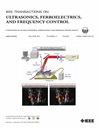图像离散化和斑块大小对微气泡定位精度的影响
IF 3
2区 工程技术
Q1 ACOUSTICS
IEEE transactions on ultrasonics, ferroelectrics, and frequency control
Pub Date : 2024-10-14
DOI:10.1109/TUFFC.2024.3479710
引用次数: 0
摘要
对于超声定位显微镜来说,微气泡(MB)的定位是获得血管超分辨图的重要部分。本文分析了图像离散化和斑块大小对不同微泡定位方法精确度的影响,以调和以往研究的不同观察结果,提供可行的定位精确度估算,并得出最佳参数选择指南。为此,用随机生成的子像素位置上宽度参数σ不等的高斯点扩散函数(PSF)模拟 MB 图像,并添加里氏分布噪声。在不同大小(像素数 N × N)的斑块上测试了四种定位方法:高斯拟合法、径向对称法、质量中心计算法和峰值检测法。此外,还计算了给定估计问题的克拉梅尔-拉奥下限(CRLB)。我们的结果表明,PSF 宽度参数 σ 与像素尺寸 Δ 的比率以及补丁尺寸 N 对定位精度有很大影响。一般来说,非常小的σ/Δ 比值以及大的σ/Δ 比值与小的 N 相结合会导致性能下降。作为基于模型拟合的代表,高斯拟合接近于 CRLB,如果 N 与 PSF 相适应,对于图像离散化给出的 σ/Δ 比,高斯拟合总是表现最佳。要使用高斯拟合和径向对称法取得良好效果,一个好的经验法则是设置像素大小 Δ ≤ σ/0.6,补丁大小 N ≥ 2σ/Δ + 3。本文章由计算机程序翻译,如有差异,请以英文原文为准。
Influence of Image Discretization and Patch Size on Microbubble Localization Precision
For ultrasound localization microscopy, the localization of microbubbles (MBs) is an essential part to obtain super-resolved maps of the vasculature. This article analyzes the impact of image discretization and patch size on the precision of different MB localization methods to reconcile different observations from previous studies, provide an estimate of feasible localization precision, and derive guidelines for an optimal parameter selection. For this purpose, the images of MBs were simulated with Gaussian point-spread functions (PSFs) of varying width parameter
$\boldsymbol {\sigma }$
at randomly generated subpixel positions, and Rician distributed noise was added. Four localization methods were tested on the patches of different sizes (number of pixels
${N}\times {N}$
): Gaussian fit (GF), radial symmetry (RS) method, calculation of center of mass (CoM), and peak detection (PD). Additionally, the Cramér-Rao lower bound (CRLB) for the given estimation problem was calculated. Our results show that the localization precision is strongly influenced by the ratio of the PSF width parameter
$\boldsymbol {\sigma }$
to the pixel size
$\boldsymbol {\Delta }$
, as well as the patch size N. The best parameter combination depends on the localization method. Generally, very small
$\boldsymbol {\sigma /}{\boldsymbol {\Delta }}$
ratios as well as large
$\boldsymbol {\sigma /}{\boldsymbol {\Delta }}$
ratios in combination with small N lead to performance degradation. The GF as a representative of a model-based fit comes close to the CRLB and always performs best for the
$\boldsymbol {\sigma /}{\boldsymbol {\Delta }}$
ratios given by image discretization if N is adapted to the PSF. To achieve good results with the GF and the RS method, a good rule of thumb is to set the pixel sizes
${\boldsymbol {\Delta }}\boldsymbol {\le \sigma /0.6}$
and the patch sizes
${{N}\ge {2}\sigma /}\boldsymbol {\Delta }{+3}$
.
求助全文
通过发布文献求助,成功后即可免费获取论文全文。
去求助
来源期刊
CiteScore
7.70
自引率
16.70%
发文量
583
审稿时长
4.5 months
期刊介绍:
IEEE Transactions on Ultrasonics, Ferroelectrics and Frequency Control includes the theory, technology, materials, and applications relating to: (1) the generation, transmission, and detection of ultrasonic waves and related phenomena; (2) medical ultrasound, including hyperthermia, bioeffects, tissue characterization and imaging; (3) ferroelectric, piezoelectric, and piezomagnetic materials, including crystals, polycrystalline solids, films, polymers, and composites; (4) frequency control, timing and time distribution, including crystal oscillators and other means of classical frequency control, and atomic, molecular and laser frequency control standards. Areas of interest range from fundamental studies to the design and/or applications of devices and systems.

 求助内容:
求助内容: 应助结果提醒方式:
应助结果提醒方式:


